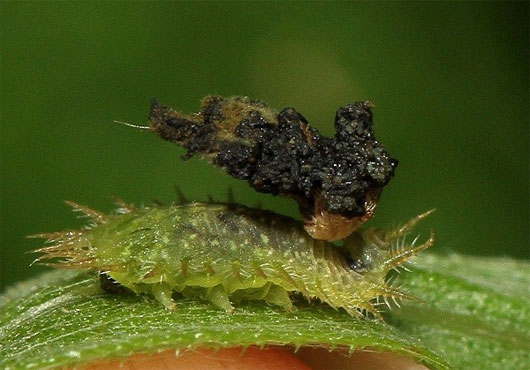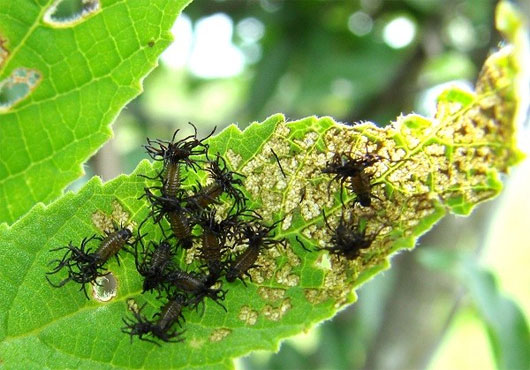Types of insects that have tactics
Do not abandon teammates, alliances and use mercenaries . are extremely unique "military tactics" of insects.
Few doubts, images of insects running rampant or nonsense, seemingly normalized, turned out to contain many deep tactics like 'people'. Let's come to the 'military tactics' coming from insects, according to the Cracked page.
1. Beetles build shields

The ancient Roman or Sparta warriors often applied the shield-making strategy, forming a strong, unstoppable shield wall against the enemy. But unexpectedly, this strategy also appeared in the hard-winged ladybug Cassidinae (tortoise beetle).
When 'new born', they are fragile and vulnerable. So, the bugs found a way to build their 'shield' around them against the enemy and they used it . their feces.

However, the frighteningness of the 'feces shield' is not enough, so Cassidinae has a more impressive idea, which is to assemble and make a huge, solid feces shield.
The bugs on the inside of the shield face upwards, the rest put the shield outward. When attacked, their enemies often retreat when tripping over this horrible wall.
2. Bees besieged to occupy another team
After observing, scientists discovered that the bees of Trigona genus (consisting of non-venomous bees) had a very human-like invasion strategy. In ancient times, when the war of aggression occurred, a common faction surrounded, attacked and isolated the enemy stronghold for a very long time, until one of the two factions gave up.

This species of bees, too, when invaded, each giant herd will surround the nest, beating wings to make noise to provoke the other worker bees to fight. This bee has no venom, but has a sharp jaw and is very strong. They grabbed the enemy, crushed their heads with their teeth or crushed them to death, leaving a mountain of corpses every time the war took place.
Scientists say the bees are especially like humans in that, the invasion can last for weeks. And like war in humans, the scope of the war will spread out, attracting bees from many other teams - up to 7 neighboring groups - to participate in the war.
3. Ants alliance and use mercenaries
Historically, the key to victory was to possess a 'full-time' fighting force. But for 'farmer-ant', they don't own this.

Farm ants have evolved to be able to do many things, but not enough to deal with 'bullies' like the ants (Megalomyrmex) - those who always go to their territory and . demand food.
However, biologists said that it turned out that the farmer ants always welcomed these bullies. The reason is because farmers always face the danger of invading other ants. The consequences of these wars are "pathetic": most worker ants are killed, and larvae are captured as slaves.

So, Megalomyrmex is acting as a 'conservator'. As the other army of adversaries approached, the giant Megalomyrmex ants would advance to fight and protect the nest. In return, farm ants will provide food for them.
Ants also allied themselves against the enemy, especially for the Formica sanguinea species - the ants that captured slaves. When pursued by Formica ants, weaker species will flee until they reach the territory of Lasius fuliginosus ants. Lasius ants will merge with weaker species and . 'protect the world'.
4. Organized military organization
Owning a warlike army is a dream for any society, but if used incorrectly, all is meaningless. This is what makes the fears of termites, they form a strong and organized army like the ancient Sparta warriors.
Most beetles have other simple attack tactics - hitting the place where the queen lives, but for Hospitalitermes, they build tactics like humans.

When marching, the food search team will be escorted by soldiers. The army will split into 3 groups: the first group of soldiers will leave the first group, followed by the workmen and finally the escort. When the party is out of the nest, the soldiers will move to the two sides against the enemy, while the termite will enter, find food and bring it back to the nest.
When protecting the nest, the term Macrotermes has a more remarkable tactic. Every time an enemy (usually an ant) tries to attack, the soldier knocks simultaneously on the wall to alert the entire group. After that, the soldiers will block all holes, ready to sacrifice in order to repel the enemy, and at the same time the repairmen repair the damaged areas.
5. Ants don't abandon teammates
What makes people different, is that we don't leave each other in need. A few animals have similar actions but insects are special. They can sacrifice the herd for the benefit of the whole team, except ants.
In 1874, biologists found that some ants spent time rescuing teammates trapped in the sand. Modern science decided to study this problem by burying a series of traps in nylon strings. And amazingly, instead of continuing to march, the queen ordered to rescue the prisoners by digging the soil and chewing on the nylon string, until the "prisoners" were released.

Even, ants are willing to sacrifice to rescue teammates. The researchers conducted the experiment by bringing a group of ants into the hole of lion ants. When the lion ant captures a victim, other ants try to escape by biting and burning the 'giant'.
If lucky, the captured ant will be freed, but the rescued ant will become the next victim. At this time, instead of running away, the newly saved ant continued to rush to rescue his teammates.
However, this noble gesture only exists in the same territory. In another experiment, the other ants when trapped will be abandoned, even tortured and killed when they cannot do anything.
- The insects are the most favored of the planet
- Strange but particularly effective hunting tactics in the natural world
- Top 10 weird insects
- Sexual tactics of animals
- 10 scary weapons and tactics in ancient war
- Insect-eating insects like to eat
- Decode extreme military tactics of the Ottoman Empire
- Set of brilliant photos showing off
- 6 strange tactics create unexpected victories in the history of war
- 4 military tactics have 1-0-2 in history only genius thought out
- Assassin insects in nature
- What will happen if insects disappear from Earth?
 Why do potatoes have eyes?
Why do potatoes have eyes? 'Tragedy' the world's largest carnivorous life: Death becomes ... public toilet
'Tragedy' the world's largest carnivorous life: Death becomes ... public toilet Tomatoes were once considered 'poisonous' for 200 years
Tomatoes were once considered 'poisonous' for 200 years Detecting microscopic parasites on human face
Detecting microscopic parasites on human face